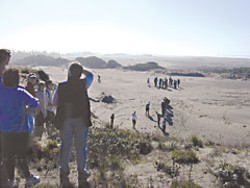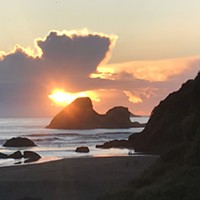[
{
"name": "Top Stories Video Pair",
"insertPoint": "7",
"component": "17087298",
"parentWrapperClass": "fdn-ads-inline-content-block",
"requiredCountToDisplay": "1"
}
]
When I moved to Humboldt County 15 years ago I spotted what I am convinced was a ringtailed cat crossing Samoa Boulevard past the Sierra Pacific Mill. The long, ringed, fluffy tail was unmistakable, though I have yet to verify this sighting. This is part of the mystery the Pacific dunes hold for me.
Now, I collect mushrooms and have been known to go places I should not go, reasoning that of all extractive forest enterprises, mushroom harvesting is the most benign. It is akin to picking a peach off a tree and it does no harm. I have been on the King's Domain, and I have been on private timber lands. Having said that, I would never take anything from the Pacific dunes that I was not authorized to, even though it is the richest mushroom land anywhere in Humboldt County, hosting mushrooms that should not be on the coast. This place is far too precious a place to mess around with.
Some of these dunes are about to receive the general recognition they deserve, and will equal or eclipse the Arcata Marsh in tourist importance. The North Spit/Arcata dune complex is only 4.5 miles from the Arcata Plaza and hosts, along with fabulous animal and plant life, rare dunes geology, views and vistas not seen anywhere south of Oregon Dunes National Park. This narrow strip of beautiful and rare coastal California property is on the verge of becoming an important outdoor natural recreation area and destination. The heretofore crazy three-mile patchwork of federal, state and local sand dunes (some more than 100 feet high), marshes and rare coastal forests are about to become knitted together into a single complementary unit. Parking is already in place, major trails are open and, most exciting, a full-featured nature and education center with facilities is slated to open in the next year.
1. The Lanphere Dunes Preserveis the northernmost parcel in the chain and the most difficult to enter, because of its remoteness, fragility and jurisdiction. Lanphere is also the oldest, dating back to 1974 when HSU biology professors William and Hortense Lanphere donated their land to the Nature Conservancy. They were tired of dune buggies encroaching on their land.
Like all the dune properties, this magical area was left behind by a retreating glacier 12,000 years ago: The property (according to its new owner, the Humboldt Bay National Wildlife Refuge Complex) contains "the most pristine remaining dune ecosystem in the Pacific Northwest and supports rare and representative examples of older forested dunes, young active dunes, dune swale wetlands and coastal salt marsh."
You can see reindeer lichen that belongs above the Arctic Circle, along with dozens of other species. It is also home to porcupines, weasels, foxes, bobcats and deer. Lanphere remains virtually off-limits to the public and there remains a controlled gate at the property. Access is restricted to guided public walks and special individual use permits.
2. Just south along the ocean and adjoining Lanphere is Ma-le'l North, the U.S. Fish and Wildlife Service-managed portion of the Ma-le'l Dunes Cooperative Management Area (CMA). Like Lanphere, this 160-acre property (purchased in 2005 with funding from the State Coastal Conservancy) is fragile, rare and intended as a natural reserve, so will be open to the public on a limited basis. There will be a small parking lot and the area is restricted to hiking and nature tours.
3. Ma-le'l South is the really exciting section right now. It is part of the same CMA as Ma-le'l North but is owned by the Bureau of Land Management, and so is less restricted. It's now open to the public seven day a week during daylight hours. A brand new parking lot, facilities and several miles of trails are available for hiking, wildlife viewing, photography, horseback riding and dog walking. Just turn toward the ocean onto Young Lane (off Samoa Blvd after the Sierra Pacific mill) and then an immediately left on Vera Linda Lane. A short 100-yard drive brings you into the parking lot.
Though the Ma-le'l South section will include more use options it is still a beautiful and rare, fragile dune system. You can hike up and over 100-foot drifting sand hills, and look out for miles over the coastal plain, the Pacific and an ever-changing rolling dune landscape. Like all the areas, Ma-le'l South is home to the Humboldt Bay wallflower, a federally endangered species that lives nowhere in the world but Lamphere Dunes and the South Spit.
4. Stamps. The Stamps property and house is the latest (purchased August 2007) and the nearest addition to the Dunes complex. This small piece of property (only 38 acres) along with the old Stamps residence (that concrete Quonset-like structure you see on the dune bluff off Stamps Lane) might be the key purchase in the larger Ma-le'l plan. According to Carol Vander Meer, Executive Director of the Friends of the Dunes, the organization that purchased the property, a restoration and management plan is being developed that will "help us conduct restoration activities (especially removal of invasive dune plants such as European beachgrass, Yellow bush lupine, iceplant, etc). It will map the property and plan where the trails will be, and the layout, design, and redevelopment of the Stamps house into an interpretative center."
So soon (probably within the next year or two) the "Humboldt Bay Coastal Education Center and Reserve" will open to the public. It will house a nature center and be staffed with trained naturalists and docents, and there will be connections to miles of walking, birding, hiking and horse trails from the Mad River slough and Lanphere dunes in the north to the Manila Dunes in the south.
Speaking of Outdoors
more from the author
-
North to Alaska
In which Dan the Faller Man escapes the choker-setting life
- Mar 13, 2008
-
My Worst Job
In which Dan the Faller Man remembers his choker-setter days
- Feb 28, 2008
-
Ab Fab
Stalking the abalone, and living to tell the tale
- Feb 14, 2008
- More »



































